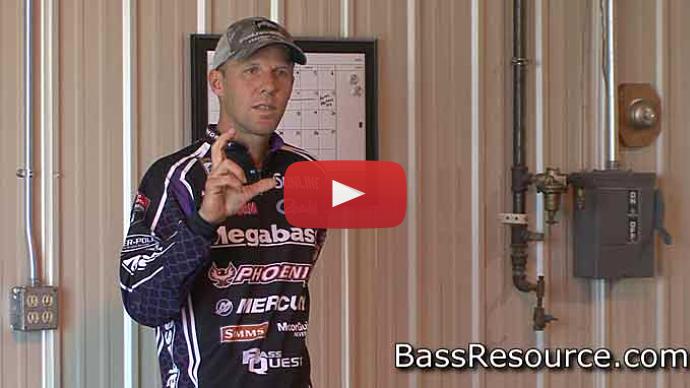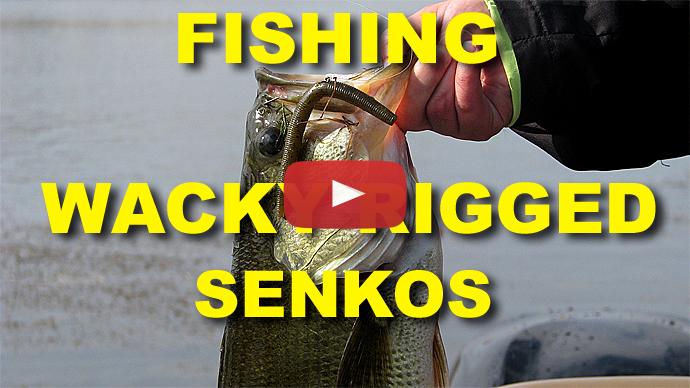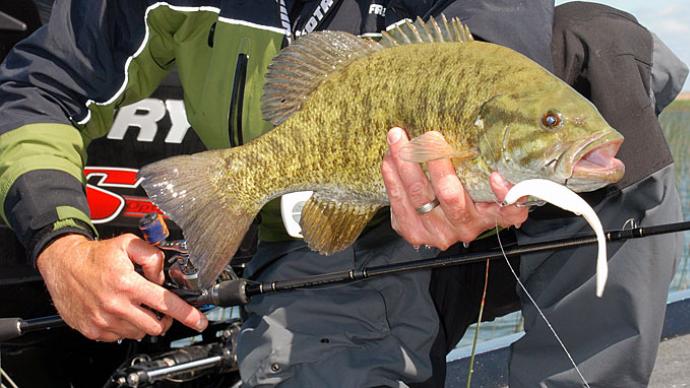I'm here in Lake Murray in South Carolina. Lake Murray is well known for the double fluke rig. I was here just this last year at the Forrest Wood Cup and I caught a lot of fish on the double fluke rig, and so did a lot of other guys in the competition. What is double fluke rig? I want to show you how I like to rig it up, and I'm going to show you how I like to fish it.
First, let's talk about rigging it up. I like to rig it up on a long spinning rod. This is in a Okuma seven foot Helio spinning rod with an RTX spinning reel, and I like braided line. This is P-Line 10 pound X-braid. I like the light, light braid. Casts far and it's sensitive, so on those long casts and you go to set the hook you're going to drive those hooks in.
So once I get that rigged up, then I'm going to rig up the double fluke rig, let me show you how I do that. You're going to need a couple things. You're going to need two baits, these are your basic little shad, little straight tailed shad baits right there, work real well. That's what I like to put the double fluke rig on. You're going to need two swivels, and you're going to need two hooks because again it's a double fluke rig.
So what I like to do is I'd like to first put on a swivel. Put a swivel on your line, okay? Look at that, just there I'm not going to tie it, it's just going to stay just like that. Then, okay, I want to tie a palomar knot to the second swivel. I'm going to do the second swivel, tie a palomar knot, standard palomar. Okay, cut that off, a little tag end there. So now what I have is one swivel tied to my main line and one swivel that can slide. okay? Follow me? So there's two swivels there.
Now what I'm going to do, is I'm going to take my main swivel, the one that's tied, and I'm going to take a piece of fluorocarbon. I like the P-Line this is 100% fluorocarbon by P-Line. This is 12 pound test and I'm going to tie a palomar knot, okay? I'm going to connect this leader to that swivel that's connected to my main line, okay?
All right. Now, main line with the main swivel, I have a piece of about two and a half foot of fluorocarbon. And then I'll attach my favorite hook, I like an offset hook this is a Trokar offset right here. Like a 3/0 or 4/0R really whatever's going to match your little shad bait, tie that on with a palomar knot for now.
Just to give you another overview where we're at so far, I have my main swivel tied to my main line with one swivel that slides. Okay, we haven't done anything to that second swivel yet, got a two foot piece of fluorocarbon leader tied to my favorite Trokar hook.
Okay, now we're done with that one, we're going to then attach your favorite little shad bait, little straight tailed shad bait, just rig it Texas rig. Okay, and I like to just barely expose that hook just right under the skin just right there. We're fishing this in open waters, so I don't need to worry about getting hung up on something just right under the skin just like that. Okay, now that I've got that rigged up that side's done.
Now I'm going to take this swivel that's sliding up and down and this is a real important part. I'm going to attach another piece of fluorocarbon leader with a standard palomar knot to the sliding swivel.
Here's the real important part that you have to pay attention to. Now you have one tied with the main line with the fluke and your second line is on the sliding swivel. The second line, the bait needs to be shorter than your bottom bait okay? Your main line bait. So I want it up about six inches or so. So I'm going to pull it down to six inches pinch it right there, that's where I'm going to tie my knot. Right there in that particular spot. Now, attach my bait to the second one. All right, now check this out, guys. That is rigged up the proper way.
You have one fluke above the other fluke six inches or so again, that's the shorter one that's going to be your sliding line that's the important part, that swivel is going to slide on your short line and this is your main line and it's longer. So that's how you rig it up.
Now, let me show you how you cast it out there, and let me show you how you work it.
All right so now that I've got it rigged up properly, let me show you what it looks like in the water, it's pretty amazing the way that these baits dance together.
It's a bait that I throw when these fish are schooling, when they're chasing bait. Here at Lake Murray and a lot of lakes in South Carolina we have herring, any of these shoal markers like we have here behind us that's where these fish are going to, in the morning times push the herring and the shad up and they are going to feed and this is a great bait.
Check this thing out the water, this is what it looks like when it's twitching along in the water. Look at those baits dancing along, they're just dancing along together, looks like a little mini school of bait fish coming through the water. That is what triggers those fish and it's something that the fish they don't get to see too often, I mean that is beautiful that thing is just undulating back and forth they dance together.
And having that line attached to the main line like that with these swivels it doesn't get tangled up and when you get, sometimes you'll get two fish, and when you get a second fish on the one, okay? On this one it can slide on that line and won't break your line because it can move so they can pull apart from each other that's why you want that to slide. If you have them connected together on one line or on one swivel then two big fish would pull against each other and break the line.
So here's what I like to do. I like to basically get out here on these open shoal markers, these open points here, throw it way out there like that it throws pretty far, and I work it pretty quick. Look at me just reeling my bait, reeling my baits along the surface there, twitching my rod the whole time, trying to make a little splashing, and and those baits are coming along fast. I don't go to too slow, I keep it moving pretty quick, like it's scared baitfish.
Every once in a while I'll pause it, for just a split second and let those baits, because they don't have any weight to then other than just the hook, let those baits sink down. But again long cast out there and reel it pretty quick and twitching it on the surface like that. That's how I fish a double fluke rig and it's amazing how fast those fish are when they key in on that. Boosh! They blow up on it and you'll get a bass and a lot of times, a lot of times, you'll catch two of them.
So try the double fluke rig, it's a really cool way of catching fish especially when the fish is schooling.






